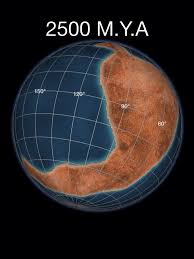Precambrian
Precambrian refers to the vast span of time before the Phanerozoic Eon, covering the formation of Earth about 4.6 billion years ago up to the emergence of complex, multicellular life forms about 541 million years ago. This period constitutes nearly 88% of Earth's history and is divided into three eons: the Hadean, Archean, and Proterozoic.
Overview[edit | edit source]
The Precambrian is characterized by the formation of the Earth, the appearance of the first life forms, and the development of conditions necessary for the proliferation of life. Due to the limited fossil record from this time, much of what is understood about the Precambrian comes from the study of metamorphic and igneous rocks and other geological formations.
Hadean Eon[edit | edit source]
The Hadean Eon (from 4.6 billion to 4 billion years ago) is named after Hades, the ancient Greek god of the underworld, reflecting the harsh conditions on the early Earth. This eon saw the formation of the Earth's crust and oceans, but due to the extreme volcanic activity and frequent asteroid impacts, conditions were too hostile for life.
Archean Eon[edit | edit source]
The Archean Eon (from 4 billion to 2.5 billion years ago) witnessed the stabilization of the Earth's crust and the appearance of the first life forms, primarily microorganisms. During this time, the atmosphere was devoid of oxygen, and life was anaerobic. The oldest known rocks and the earliest evidence of life date back to this eon.
Proterozoic Eon[edit | edit source]
The Proterozoic Eon (from 2.5 billion to 541 million years ago) is marked by significant geological, atmospheric, and biological changes. It saw the rise of atmospheric oxygen, known as the Great Oxidation Event, which led to the oxidation of iron in the oceans and the deposition of banded iron formations. This eon also witnessed the first supercontinent, Rodinia, and the emergence of more complex life forms, including the first multicellular organisms.
Significance[edit | edit source]
The Precambrian is crucial for understanding the early development of the Earth and the origins of life. It sets the stage for the Cambrian Explosion, a period at the beginning of the Phanerozoic Eon when most major animal phyla appeared. The environmental and biological developments during the Precambrian laid the foundations for the diversity of life that followed.
Challenges in Study[edit | edit source]
Studying the Precambrian is challenging due to the scarcity of fossils and the extensive metamorphism that has altered or destroyed much of the original rock record. However, advances in technology and the discovery of well-preserved sites have improved our understanding of this enigmatic period.
Search WikiMD
Ad.Tired of being Overweight? Try W8MD's physician weight loss program.
Semaglutide (Ozempic / Wegovy and Tirzepatide (Mounjaro / Zepbound) available.
Advertise on WikiMD
|
WikiMD's Wellness Encyclopedia |
| Let Food Be Thy Medicine Medicine Thy Food - Hippocrates |
Translate this page: - East Asian
中文,
日本,
한국어,
South Asian
हिन्दी,
தமிழ்,
తెలుగు,
Urdu,
ಕನ್ನಡ,
Southeast Asian
Indonesian,
Vietnamese,
Thai,
မြန်မာဘာသာ,
বাংলা
European
español,
Deutsch,
français,
Greek,
português do Brasil,
polski,
română,
русский,
Nederlands,
norsk,
svenska,
suomi,
Italian
Middle Eastern & African
عربى,
Turkish,
Persian,
Hebrew,
Afrikaans,
isiZulu,
Kiswahili,
Other
Bulgarian,
Hungarian,
Czech,
Swedish,
മലയാളം,
मराठी,
ਪੰਜਾਬੀ,
ગુજરાતી,
Portuguese,
Ukrainian
Medical Disclaimer: WikiMD is not a substitute for professional medical advice. The information on WikiMD is provided as an information resource only, may be incorrect, outdated or misleading, and is not to be used or relied on for any diagnostic or treatment purposes. Please consult your health care provider before making any healthcare decisions or for guidance about a specific medical condition. WikiMD expressly disclaims responsibility, and shall have no liability, for any damages, loss, injury, or liability whatsoever suffered as a result of your reliance on the information contained in this site. By visiting this site you agree to the foregoing terms and conditions, which may from time to time be changed or supplemented by WikiMD. If you do not agree to the foregoing terms and conditions, you should not enter or use this site. See full disclaimer.
Credits:Most images are courtesy of Wikimedia commons, and templates, categories Wikipedia, licensed under CC BY SA or similar.
Contributors: Prab R. Tumpati, MD





